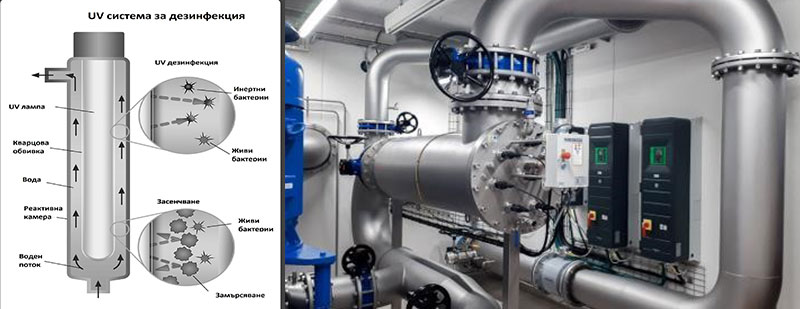Providing potable water is a vital step in protecting public health from dangerous microorganisms. The demand for cost-effective solutions for providing clean drinking water and decontamination of industrial wastewater is constantly increasing.
As industry regulations become more stringent, increasing interest and the evolution of resistant strains of bacteria have led to the successful application of alternative treatment methods, such as UV water treatment. UV disinfection solves this challenge by being able to meet the most stringent requirements in terms of protection against bacteria and viruses.
Highly chlorinated drinking water has been shown to lead to several health complications such as respiratory diseases. While chlorine has proven ineffective against parasites such as Cryptosporidium and Giardia, UV rays are able to easily inactivate these pathogens at very low doses. This means that UV treatment is able to deactivate all bacteria, viruses, molds and spores that may be present in drinking water.
What exactly is UV disinfection and how does it work?
The UV disinfection system is an extremely effective way to combat microbial contamination in water. However, microbes must be exposed to UV-C light in an appropriate amount to effectively disinfect water. UV disinfection systems are used in many different applications, ranging from the purification of drinking water in individual homes to the disinfection of water supplies of entire cities to the treatment of industrial wastewater. UV water treatment is recognized as a safer and more cost-effective way to disinfect water for industrial applications. UV disinfection is useful in almost any application where safe and clean germ-free water is required; and where the water is likely to be contaminated before it reaches the final point of use.
In UV water disinfection technology, ultraviolet light with a wavelength of 253.7 nanometers is used to disinfect bacteria, viruses, molds, algae and other microorganisms that multiply and grow. UV disinfection technology destroys the DNA of microorganisms, leaving them dead and unable to grow further. UV disinfection technology can be used for drinking water disinfection, process water disinfection, wastewater disinfection and surface disinfection. In addition to disinfection applications, this technology can also be used for TOC removal and ozone destruction. It also has a UV sterilizer for hospitals, factories and offices
In UV water disinfection technology, UV light disinfects by penetrating microorganisms and destroying their DNA. DNA plays an important role in the functions of organisms and reproduction, therefore the destruction of DNA prevents the organism from being active and reproducing. This ultraviolet energy (wavelength 240-280 nm) is also found naturally in sunlight in very small amounts. The same energy is produced at a higher intensity using high-mercury discharge lamps known as UV lamps.
No bacteria, viruses, molds or their spores can survive when exposed to the correct dose of UV light. Therefore, UV is considered the best solution for water disinfection, and for room sterilization, there is a UV mobile disinfection machine that can be used.
Application of UV systems
The UV disinfection system is not just a lamp in a tube. The UV reactor must be designed to ensure that all microbes receive sufficient UV light exposure (dose). Based on the hydraulic properties of water; the reactor must be optimized to direct the flow in a manner that maximizes residence time and increases turbulence. Well-designed industrial UV water disinfection systems consistently deliver outstanding results in industrial applications.
This type of disinfection systems can be applicable in the following industries:
- Food industry – The UV disinfection system can help achieve high water quality according to pre-set specifications
- Pharmaceutical – Water used in pharmaceutical and healthcare products and for CIP (clean-in-place) must be free of chemicals such as chlorine, ozone and pathogens. Most pharmaceutical companies rely on UV systems for water disinfection..
- Cosmetics industry – water that does not contain microorganisms and toxins guarantees the quality and extends the shelf life of cosmetics. UV sterilization is the preferred choice for the cosmetic industry worldwide.
- Drinking water supply – a UV drinking water disinfection system is an easy and affordable solution to ensure clean water in every tap of your home or office
- Disinfection and Reuse of Waste Water – To combat the problems of water scarcity and the rising cost of water, UV disinfection can help by treating the wastewater in the tertiary stage. UV systems that are specifically designed for wastewater can thus disinfect the wastewater so that the water can be reused for secondary purposes such as flushing and gardening.
- Swimming pools – Traditionally, chlorine has been used to provide clean water in swimming pools. However, it is increasingly known that in chemical disinfection, the chemical reacts with many other organic substances to form hundreds of new chemicals that are harmful. UV systems, in turn, are recognized as a safer and more cost-effective way to disinfect swimming pools.
Advantages of UV disinfection systems
- Natural – UV is the natural way to purify.
- Environmentally friendly – no toxic by-products are formed during the UV disinfection process
- Effective – All known microorganisms are susceptible to UV light
- Economical – Lowest operating costs among disinfection systems
- Safe and Chemical Free – No added chemicals, therefore no danger of overdose
- Fast – this is contact purification, therefore immediate
- Easy to manage – Well designed systems come with many advanced features such as high efficiency electronic ballasts and highly accurate UV intensity monitors that make them very efficient and therefore easy to manage
Support
There may be cases where the water is not properly pre-treated and the turbidity levels are low. Then a routine inspection and cleaning of the lamp is carried out every 6 months. In the case of high turbidity and hardness, the cleaning frequency may even need to be increased. Finally, the UV lamp has a limited life and must be replaced after it wears out. In the unlikely event of premature lamp failure, the monitoring circuit will provide a signal to recommend replacement.
Comparison between ozonation, chlorination and UV disinfection systems
| UV desinfection | Chlorination | Ozonation | |
| Capital expenditure | Low | Lowest | High |
| Operating expenses | Lowest | Low | High |
| Ease of installation | Excellent | Good | Complicated |
| Ease of maintenance | Excellent | Good | Weak |
| Required contact time for disinfection | < 10 sec | 20-30 mins | 10-20 mins |
Operational efficiency is one of the main drivers of the drinking water market. Many organizations invest in new assets that generate a return on investment based on their operational savings. Choosing UV as a disinfection method ensures optimal CAPEX and OPEX compared to its alternatives, making UV the best solution for a wide range of installations.
Contacts:
Do not hesitate to contact our specialist on email sales@atamiq.com or phone +359886163199



